Growing up I never read Nancy Drew, or even the Hardy Boys. I was always a Tom Swift, Rick Brant, Doc Savage kind of series guy.
I've always used to say to anyone who cared to listen: "The idea of reading a Nancy Drew mystery is better than the actual reading of a Nancy Drew mystery."
But like I said, I never read Nancy Drew. My statement was based merely on an assumption that the Nancy Drew Mystery Stories were probably as weak as all of the other teen series novels that I'd read, Rick Brant being the one true exception. The cover art is another matter though; it was, and still is, a magnet for interest.
Then a few years ago that I relented and read my first ever ND mystery and it turned out to be a pleasant surprise.
Then I binged two dozen more, from the originals to the revised editions
to the digests to the paperbacks. Even a crossover. And surprisingly, they
were all mostly okay, generally brisk and adventurous. Some were better than others, that's only to be
expected, but I've no doubt that when these novels were first read by
their target audience they were genuinely satisfying, and still are it would seem. Nancy Drew
has stood the test of time for a reason, and that reason has a lot to do with the mystery stories themselves. But I would also argue that there at least two other reasons as well; Nancy herself, with her courageous, virtuous, inquisitive and uncompromising character--and the cover art.
I'm an old dude now but enjoying an ND cover isn't something that's weird on my part. I don't see Nancy as a sex symbol necessarily, although for boys in her age demographic she most assuredly is. For me, I see only the adventure aspect of the art. That's the appeal. I love living vicariously thru the cover art of a book (its contents too of course), especially if adventure and mystery are at the core of what's being shown. And it doesn't matter whether that core is male or female.
And let's be honest; most of us have never experienced the kind of adventures that Nancy Drew routinely had, or that Tom, Rick, Doc, or Frank and Joe Hardy had in their books. Sure, we all had our share of real adventures growing up; I remember a sprawling old farm in my neighborhood that my brother Gary and I snuck onto when we were about 10. It was great fun until the doberman's came at us, and then it became a harrowing adventure. I don't know about you, but none of our other adventures involved criminal activity or actual sleuthing. So cover art, and stories, can take us where we all would have liked to have been, or be: exploring a spooky old house, or an immense castle, or a derelict old ship. Finding a secret passage, or a hidden treasure. Riding horses on a dude ranch or driving a convertible. Sailing. Boating. Canoeing. Saving someone's life. Seeing ghosts or other strange phenomena. Discovering the hideout of a criminal gang and putting the kibosh on them. Getting conked on the head and tied up (okay, I think we can all do without that last action).
The Nancy Drew books have been ghostwritten by a number of different authors under the collective house pseudonym Carolyn Keene, but the character was conceived initially by its first publisher, Edward Stratemeyer, the founder of the highly successful publishing company, the Stratemeyer Syndicate (founded 1899).
The first ND author was Mildred Wirt, later Mildred Wirt Benson (1905-2002). She wrote 23 of the originals books out of 56 total (in actuality it has grown to 175 total), beginning with The Secret of the Old Clock in 1930. The second author was Stratemeyer's daughter, Harriet Stratemeyer Adams (1892-1982), who, along with her sister Edna, inherited the Syndicate upon her father's death in 1930. Harriet wrote 26 of the originals and rewrote an additional eight. To quote someone else, "Mildred may have created the Nancy Drew voice, but Harriet refined and ultimately defined it." Of the rest, there was Walter Karig, who wrote three ND's in the 1930's, George Waller Jr. and Wilhelmina Rankin, who co-wrote one title each with Harriet. A single title was written each by Margaret Scherf, Alma Sasse and Charles Strong.

The first Nancy Drew artist was Russel Haviland Tandy (1891-1963).
Tandy produced 25 dust jackets, from 1930 to 1950, consisting of volumes 1-10 and 12-26. Tandy also drew the silhouette endpages which were used on all of the early editions (seen above), and all of the glossy frontispieces and interior illustrations for volumes 1 through 13. That's what we're going to look at here, or as much of it as can be had. The interior illustrations were dropped after that, and on later editions both they and the frontispieces were printed on just plain paper. If you come across an old ND that has all of its illustrations on glossy paper, snatch it up for goodness sake--it's a rare item these days.
In addition to the Nancy Drew books, Tandy spent over twenty years illustrating juveniles, mostly for Grosset & Dunlap (the primary publisher of Stratemeyer Syndicate titles) and Cupples & Leon. Those included the Hardy Boys, Beverly Gray and Dana Girls series, among many others.
After graduating from the Art Student's League in 1917, and before taking on books, Tandy began producing fashion illustrations for various department store catalogs such as Sears, J.C. Penney and Montgomery Ward, and in the last ten years before retirement he was back doing the same thing, this time for Lord & Taylor and Saks Fifth Avenue. Somehow between all of those commercial assignments and book illustrations he found time to be a band director, song writer, and trumpet soloist.

Volume One: THE SECRET OF THE OLD CLOCK (Grosset & Dunlap, 1930). This, I think, is the most charming Tandy cover of them all, and it's no wonder the series went on to become one of the bestselling teen series of all time. The sad part is that most of Tandy's artwork was lost in a house fire in 1962. The only ND's that survived are two paintings, The Mystery of the Moss-Covered Mansion (1941) and The Secret in the Old Attic (1944), plus a couple of sketches of Grace Horton, his primary ND model.
Volume Two: THE HIDDEN STAIRCASE (Grosset & Dunlap, 1930). Ah, the proverbial flashlight. Somewhere I read that this image is the most replicated one in the entire ND canon by fans who like to draw and paint. Makes sense, nothing says Nancy Drew more that this cover.
Volume Three. THE BUNGALOW MYSTERY (Grosset & Dunlap, 1930). Always an inquisitive one, that Nancy. Or as some would say, nosy.
Volume Four: THE MYSTERY AT LILAC INN (Grosset & Dunlap, 1930). Eavesdropping again? It's no wonder Nancy's always finding trouble.
Volume Five: THE SECRET AT SHADOW RANCH (Grosset & Dunlap, 1931). Don't get involved in someone else's problems girl, just keep riding in the opposite direction. Oh, blast it all! Will you never learn?
Volume Six: THE SECRET OF RED GATE FARM (Grosset & Dunlap, 1931). Care to guess which political party these dancing fools belong to?

Volume Seven: THE CLUE IN THE DIARY (Grosset & Dunlap, 1932). Nancy's virtue would never let her walk past a book lying on the ground.
Volume Eight: NANCY'S MYSTERIOUS LETTER (Grosset & Dunlap, 1932). Nancy looks decidedly older here to me. Or maybe it's just the fur coat and rouge.
Volume Nine: THE SIGN OF THE TWISTED CANDLES (Grosset & Dunlap, 1933). That's the most weirdly situated unframed door I have ever seen.
Volume Ten: THE PASSWORD TO LARKSPUR LANE (Grosset & Dunlap, 1933). While I was reading the ND's I dug around to see what other folks thought about the books, including rankings or favorites. V.10 was considered one of the best by more than one person, with one blogger claiming it was the best. Everything's subjective though. There is no best, unless your talking about the Dune series or the Song of Fire and Ice series, and then their first volumes are--period.
Tandy was unavailable for Volume Eleven, THE CLUE OF THE BROKEN LOCKET (Grosset & Dunlap, 1934), for reasons unknown. Norman Braley produced the dust jacket art instead. It's a good illustration, rather typical of the era, and also the first to depict Nancy's best friends George and Bess, but also somewhat staid compared to Tandy's illustrations.
Volume Twelve: THE MESSAGE IN THE HOLLOW OAK (Grosset & Dunlap, 1935). Tandy always seemed to dress Nancy in the most fashionable clothing of the period.

Volume Thirteen: THE MYSTERY OF THE IVORY CHARM (Grosset & Dunlap, 1936). Apparently, back in the 1930s, men whipped their dogs to get them to do what they wanted. You can be sure they never picked up after them either.
Volume Fourteen: THE WHISPERING STATUE (Grosset & Dunlap, 1937). Statues always make great yard art.
Volume Fifteen: THE HAUNTED BRIDGE (Grosset & Dunlap, 1937). Note the strong, patriotic colors that Nancy has on. Too bad those colors have been usurped by someone else who would rather destroy democracy than preserve it.
Volume Sixteen: THE CLUE OF THE TAPPING HEELS (Grosset & Dunlap, 1939). It may not be breaking, but it's definitely entering! This is the first cover illustration by Tandy to feature Nancy's friends Bess and George.
Volume Seventeen: THE MYSTERY OF THE BRASS BOUND TRUNK (Grosset & Dunlap, 1940). Again, you gotta love that period clothing. So cool.
Volume Eighteen: THE MYSTERY AT THE MOSS-COVERED MANSION (Grosset & Dunlap, 1941). Bah! All I ever found by digging around in the dirt was a couple of old plastic army men.
Volume Nineteen: THE QUEST OF THE MISSING MAP (Grosset & Dunlap, 1942). In Nancy's universe every house has a hidden door. And a furtive crook!
Volume Twenty: THE CLUE IN THE JEWEL BOX (Grosset & Dunlap, 1943). When Nancy's not spying on someone else, they're spying on her.
Volume Twenty-one: THE SECRET IN THE OLD ATTIC (Grosset & Dunlap, 1944). This is an image of the original Tandy painting that survived the house fire. It sold at auction in 2018 for $35,000. I'm surprised it didn't go for more. It's a watercolor, gouache, pencil and ink, approximately 22 x 16 inches. Tandy actually painted the font on himself, and on all of the ND's for that matter, that's why they're not always perfectly horizontal.
Volume Twenty-two: THE CLUE IN THE CRUMBLING WALL (Grosset & Dunlap, 1945). I found a small hiding place in my current home built into a basement wall. My wife wanted to drywall it over, but then we decided to cover it with a framed picture instead. Inside it I placed the two plastic army men that I'd found buried in my back yard.
Volume Twenty-three: THE MYSTERY OF THE TOLLING BELL (Grosset & Dunlap, 1945). Nancy always finds the most interesting places to visit. She should double as a tourist guide.
Volume Twenty-four: THE CLUE IN THE OLD ALBUM (Grosset & Dunlap, 1947). At first glance it appears that Nancy is spying on a man carrying a rifle, but it's actually a violin and bow. A gypsy camp, no doubt. Today we would call it a homeless camp. Or a rainbow gathering.
Volume Twenty-five: THE GHOST OF BLACKWOOD HALL (Grosset & Dunlap, 1948). This is obviously a fixer-upper and probably available back then at a price even a teenager like Nancy could afford. Though today it would probably sell for 1.4 million.
Volume Twenty-six: THE CLUE OF THE LEANING CHIMNEY (Grosset & Dunlap, 1949). In this, the very last cover by Tandy, Nancy's hair style was altered to reflect the oncoming look of the 1950s Bobby-Soxer's. That look would be carried on by Tandy's replacements, Bill Gillies, Polly Bolian, and Rudy Nappi, until about 1965 or so when it was then changed again to reflect the current styles of the day.
* * * * *
NOW LETS LOOK below at some of Tandy's frontispieces and interior illustrations from volumes 1, 2, 4, 5, 6 and 9. These are scanned from Applewood editions, which themselves are facsimile printings of the original Grosset & Dunlap editions. When Applewood introduced them back in the early 1990's, priced at $14.95, they sold like hotcakes. Well--at first anyway, but then sales slackened and they were ultimately discontinued, ending at only 21 volumes. Since then, and not surprisingly, these facsimile volumes in their first printing state have become highly collectible.
Volume One: THE SECRET OF THE OLD CLOCK (1930). Tandy continued to pour on the charm with these, his first Nancy Drew interior illustrations, giving us our first image of Nancy driving an automobile and using a flashlight.














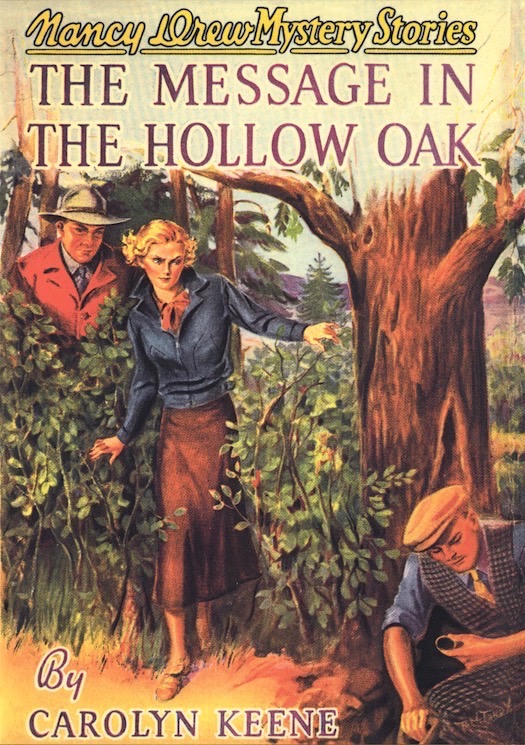



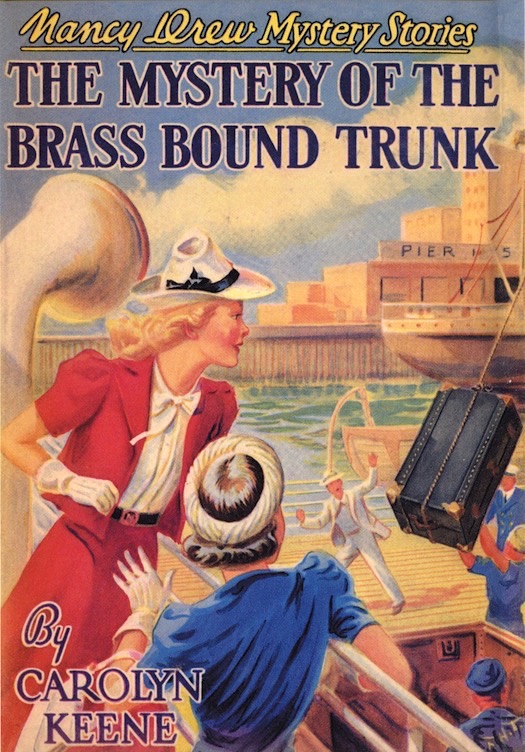


















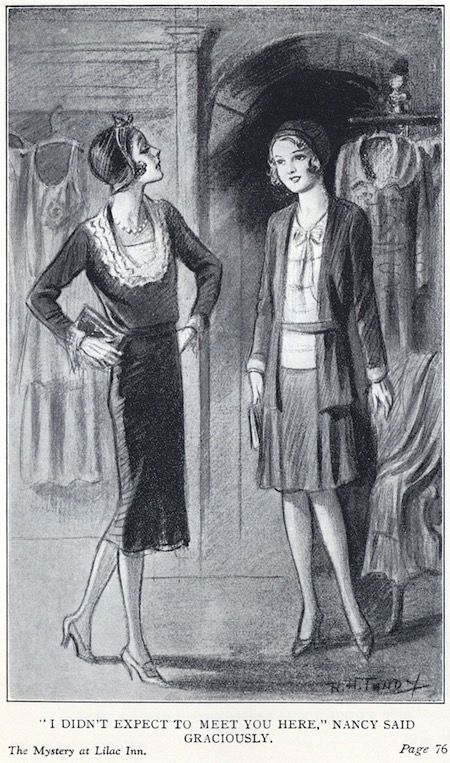
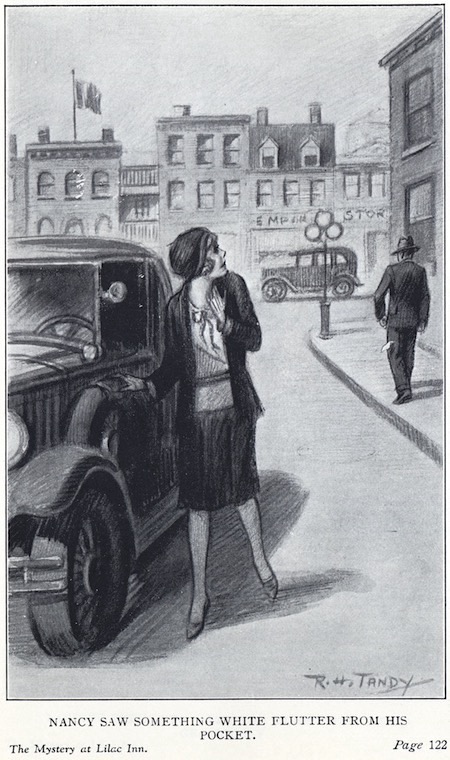

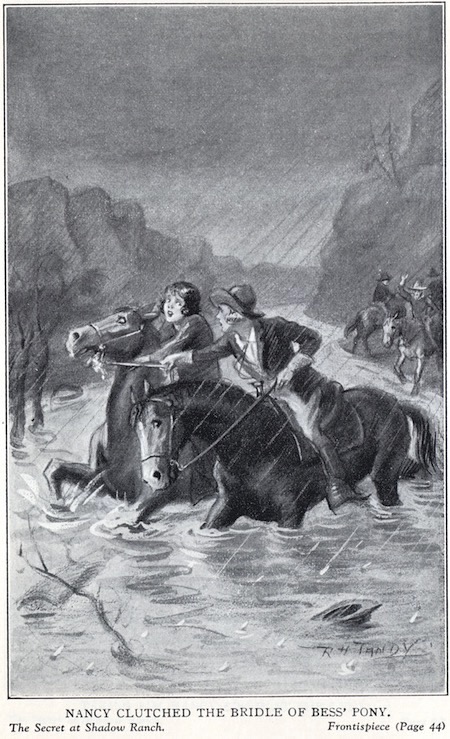



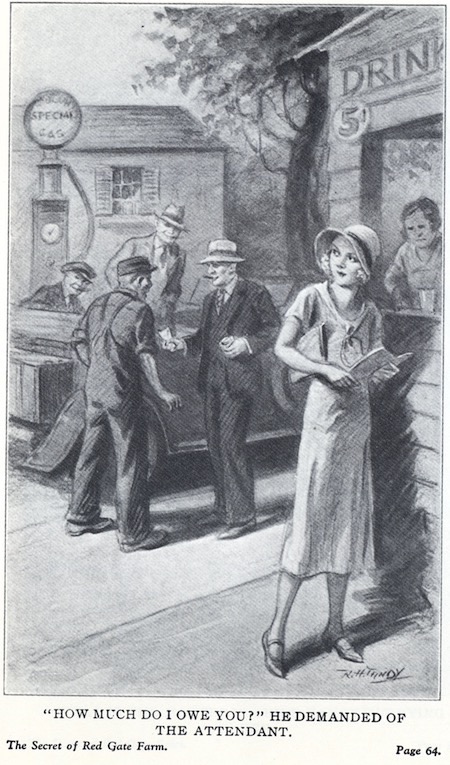
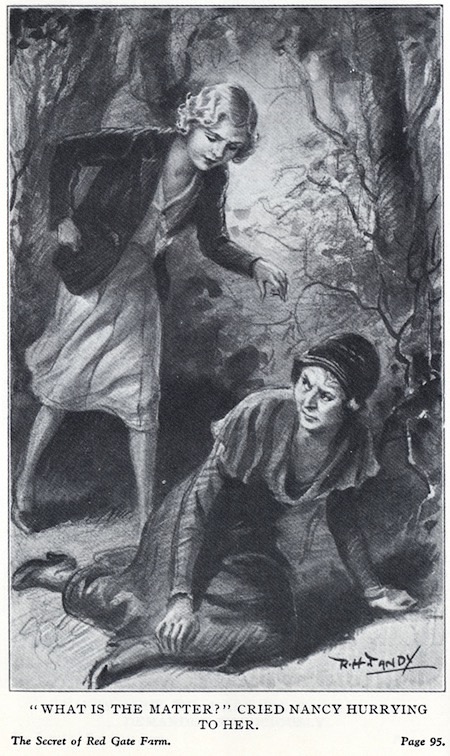







7 comments:
Wow I loved this!! I collected Nancy Drew books as a girl and I remember going to a friends house and seeing her nancy drew books had dust covers. I was so jealous now I wish I looked at them more closely.
My sister had at least a dozen ND's when she was little, and like your books they were missing the dustjackets. It's possible my dad discarded them before giving them to her--he did crazy things like that. We both think he may have thought that the jackets would just get torn up during use and show poorly on the shelf. She loved them regardless, and him too!
I enjoyed this SO much! Nancy Drew was my favourite and I devoured them in middle school. I even have a random pic in my yearbook and there Im sitting with Nancy Drew on my stack of books! Soon as I was through I would pester mom to buy me another one. Even read a few Hardy Boys. Had read every Bobsy Twins book in our library in 3rd grade I think Im sure they are gone now. I always felt special since I am a Nancy also.
This is great! I love Tandys illustrations and you've gathered them here. Are these all of them? Honestly, the covers were as important to me back in the 50's as the book was. I have a collection with all the DJs.
Tandy produced a total of 25 covers for the Nancy Drew series and yes they are all featured above.
If you like a little more of what I would call hard hitting kids mysteries, try Ken Holt books although they are getting a little hard to find.
Post a Comment